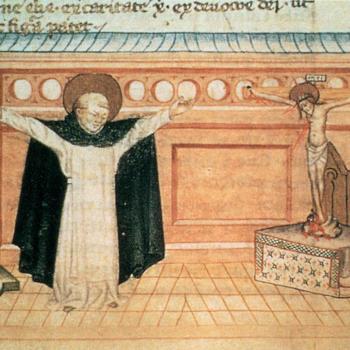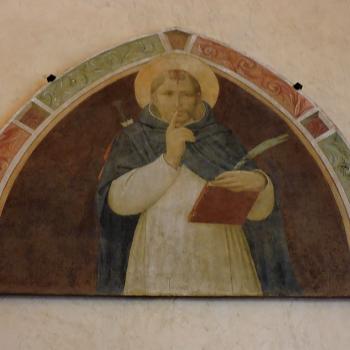Today is the prelude of God’s goodwill and the prophecy of the salvation of men. The Virgin appears openly in the Temple of God and foretells Christ to all. So let us cry to her with loud voices: Rejoice, thou who art the fulfillment of the Creator’s providence (Troparian of the Entrance of the Theotokos into the Temple)

Mary the Theotokos’ entrance into the Temple should be remembered especially for all the symbols which can be contemplated based upon the event itself. There are many which can be examined, but most important of all, we can reflect upon the nature of the Temple in Jerusalem as well as the nature of Mary becoming the Mother of God. The Temple in Jerusalem anticipated the incarnation of the Lord, for in it the presence of God could be found. But what was the purpose of the Temple? It was one of the places in which God encountered humanity so that humanity could slowly participate in his grace and prepare the line in which the God-man would be born. Thus, in and through Mary, we find the fulfillment of the mission of the Temple, for in her the God-man came to be.
“For the Son of the most high Father dwelt in the tabernacle of the Virgin Mary, and came forth from her light a mighty lion so that the whole world saw Him.”[1] In the Temple, Mary became a temple for God. But it was through the mediation of the Temple, and therefore, the whole Judaic tradition, which prepared the way for Mary and the incarnation of God, so that the Temple was not just a symbol representing the oncoming glory of God in the incarnation, but it was also a means by which God’s glory was spread across the earth. Through the Temple and its rites, God directed the people of Israel, so that Mary could be raised up from the Jews and humanity can find its right place with God.
Once she came into the Temple, Mary continued her own spiritual evolution. She was a special child, already filled with grace, but she still had a far way to go before becoming the Mother of God. At every step of the way, she could have resisted the work of God in her life, but instead, she constantly affirmed it, so that when it came to the time of the incarnation, she was more than prepared to say yes to God, not just for herself, but for the whole of humanity.
Sergius Bulgakov, in his expert way, gives us the basic details concerning the literal meaning of the feast, indicating, as well, that we receive it not from the Gospels but from sacred tradition:
The Gospel does not tell us anything about this event. But sacred tradition teaches us that, when She was only three years old, the Virgin Mary was taken into the Temple by Her parents in fulfillment of the promise they made when She was conceived. Her triumphal entry was accompanied by maidens bearing candles. She was met at the entrance to the Temple by the high priest Zacharias, who, in unknowing obedience to God’s command, led Her into the Holy of Holies, into which only the high priest had access, and that only once a year with the purifying blood. The divine child remained in the Temple, abiding in communion with angels, until She was betrothed to the righteous Joseph.[2]
To be sure, this sounds quite extraordinary. Why would Mary be taken to the Holy of Holies? Symbolically, it makes sense, as Ethiopian hymns indicate:
You are the Ark which David, that friend of Barzillai’s, celebrated with songs
When it came back from the land of the Philistines. [3]
Not only is she seen to be represented by the Ark, they say she is mystically the Sanctuary itself:
You are called the Sanctuary, which the angel measured with a rod of gold.[4]
For as God entered her, and took on humanity in and through her, she took on the presence of God. He dwelt within her, like his presence was known to be with the Ark of the Covenant, and in the Sanctuary itself. She, a woman, took on all the holiness of the Temple within herself. How can she not be welcome in the Temple? If the Ark of the Covenant could be led inside, so could she. The Holy of Holies welcomed her because her womb was to become greater than the heavens itself.
And yet, we are all led to the Holy of Holies. We are all called into the Temple, to meet with God, to listen to him and decide whether we will say yes or no to him. As Meister Eckhart tells us, “But truly I say: Everything good that all the saints have possessed, and Mary the Mother of God, and Christ in his humanity, all that is my own in this human nature.” [5] For God as became man, God has taken humanity upon himself, and so humanity, human nature itself, can be seen as a temple for God. “If, therefore, he became the temple of God by assuming human nature and we become the temple of God through his Spirit dwelling in us, it is quite clear that the material temple was a figure for us all, that is, both the Lord himself and his members which we are.”[6] Through baptism, we are all taken into the new temple and led to its Holy of Holies; with communion, we receive the presence of the Lord unto ourselves and become tabernacles, holding him unto ourselves. We are called, therefore, to enter within, to silence ourselves from all that is without. Then, in that silence, we should listen to and heed the call of the Lord upon our lives. The presentation of Mary in the Temple, therefore, anticipates our own calling. It is through Mary, of course, that the incarnation has taken place, but we, too, can give birth to God in our lives, if we follow her example and say yes to God when we come to his presence in our lives.
This mystically relates to what Jesus said to Martha:
Now as they went on their way, he entered a village; and a woman named Martha received him into her house. And she had a sister called Mary, who sat at the Lord’s feet and listened to his teaching. But Martha was distracted with much serving; and she went to him and said, “Lord, do you not care that my sister has left me to serve alone? Tell her then to help me.” But the Lord answered her, “Martha, Martha, you are anxious and troubled about many things; one thing is needful. Mary has chosen the good portion, which shall not be taken away from her” (Lk. 10:38-42 RSV).
What is this good portion which Mary had chosen that Martha had neglected? It is simply this: Mary (Martha’s sister) found her way into the temple within, wherein she encountered the presence of God and was able to glorify it with her spirit. She did not need to be anxious, for she learned she could serve Jesus by engaging God from within. The problem was not that Martha was serving Jesus, but she did so with distraction; she had not yet centered herself upon him in the temple within herself. We must not read this passage as rejecting the service of God with good works, but rather, it is about rejecting our distractions, those things which we put in the way between us and the presence of God. For we are truly called to follow the path of righteousness, to imitate Jesus, helping those who are around us, but we must do it conjoined with our relationship with God, where our focus should be on him within ourselves. Those who find God in themselves, those who truly understand what it means to be a temple of God, can never have God taken away from them (though they can turn their backs on him and leave him at their own risk).
Thus, we must remember that the entrance of the Theotokos into the Temple, though it relates to salvation history, has significance for our own spirituality. It tells us about what we can and should do ourselves. We should follow her into the Temple of God. It does not have to be the physical Temple in Jerusalem: indeed, because it is not there that we find the temple we need to enter. Rather, it is the temple we find within ourselves. We will find that the high priest, Jesus, is there waiting to take us to the Holy of Holies within ourselves. Then, we are, like Mary, to remain in the Temple, communing with angels until the end of the age, when the Bridegroom comes back for his Bride.
[1] St. Hildegard of Bingen, “Letter 220r” in The Letters of Hildegard of Bingen. Volume III. Trans. Joseph L. Baird and Radd K. Ehrman (Oxford: Oxford University Press, 2004), 12.
[2] Sergius Bulgakov, Churchly Joy. Trans. Boris Jakim (Grand Rapids, MI: William B. Eerdmans Publishing Company, 2008), 14-15.
[3] The Harp of Glory: Enzira Sebhat. Trans. John Anthony McGuckin (Crestwood, NY: St. Vladimir’s Seminary Press, 2010), 34.
[4] The Harp of Glory: Enzira Sebhat, 66.
[5] Meister Eckhart, “Sermon 5b” in Meister Eckhart: The Essential Sermons, Commentaries, Treatises and Defense. Trans. Edmund College, OSA and Bernard McGinn (New York: Paulist Press, 1981), 182.
[6] St. Bede, On the Temple. Trans. Sean Connolly (Liverpool: Liverpool University Press, 1995), 5.
Stay in touch! Like A Little Bit of Nothing on Facebook.
If you liked what you read, please consider sharing it with your friends and family!













